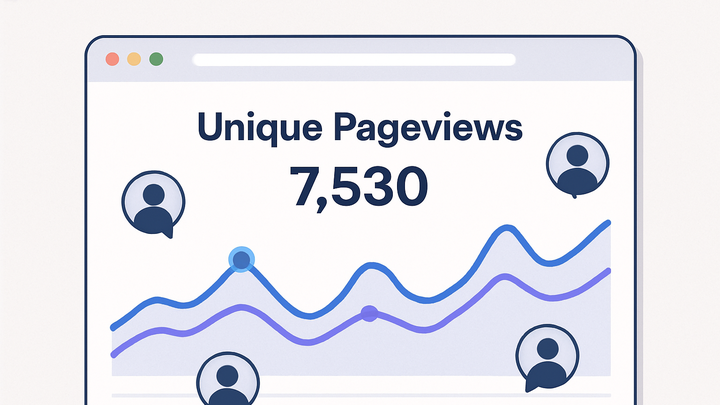Published on 2025-06-22T10:03:57Z
What is a Unique Pageview? Examples with PlainSignal and GA4
A Unique Pageview measures the number of sessions during which a specific page is viewed at least once by a user. Unlike total pageviews, which count every view of a page, unique pageviews consolidate multiple views of the same page by the same user within a single session into one. This metric helps analysts gauge the reach and first interactions of content, filtering out repeat views and thereby offering a clearer picture of user engagement. Unique pageviews are particularly useful in understanding how many distinct visits a page receives, which can inform content performance, navigation effectiveness, and UX improvements. In this article, we explore definitions, real-world importance, and implementation examples using tools like PlainSignal and Google Analytics 4 (GA4).
Unique pageview
Counts sessions where a page is viewed at least once, filtering repeat views to measure distinct interactions.
Understanding Unique Pageviews
Unique pageviews represent the number of sessions where a user views a page at least once, combining all repeated views within that session into a single count. This section dives into the core definition, differences from standard pageviews, and why the session scope matters for accurate engagement analysis.
-
Definition and scope
- Measures one view per page per session.
- Consolidates multiple views into a single count.
- Provides clarity on distinct content interactions.
-
Pageviews vs. unique pageviews
While pageviews count every single load of a page, unique pageviews count only one per session. For example, if a user refreshes a page three times in the same session, pageviews = 3, unique pageviews = 1.
Why Unique Pageviews Matter
Unique pageviews are vital for understanding the breadth of user reach and first-time interactions with content. They help remove noise from repeated views, enabling precise measurement of content popularity and user navigation behavior.
-
Evaluating content reach
Shows how many sessions included at least one view of a page, reflecting true content reach.
-
Improving navigation and ux
Identify drop-off points by comparing unique pageviews across landing pages and funnel steps.
Tracking Unique Pageviews with PlainSignal
PlainSignal offers a simple, cookie-free analytics solution that tracks unique pageviews without relying on third-party cookies. Here’s how to implement it:
-
Code example
Add the following snippet to your HTML to enable PlainSignal tracking:
-
Html snippet
<link rel="preconnect" href="//eu.plainsignal.com/" crossorigin /> <script defer data-do="yourwebsitedomain.com" data-id="0GQV1xmtzQQ" data-api="//eu.plainsignal.com" src="//cdn.plainsignal.com/plainsignal-min.js"></script> -
Configuration details
data-do: your domain namedata-id: your PlainSignal site IDdata-api: API endpoint region
-
Tracking Unique Pageviews with Google Analytics 4
Google Analytics 4 uses the page_view event to calculate unique pageviews per session.
Implement with gtag.js or Google Tag Manager:
-
Gtag.js snippet
Include and configure gtag.js to send page_view events automatically:
-
Automatic tracking
<script async src="https://www.googletagmanager.com/gtag/js?id=G-XXXXXXXXXX"></script> <script> window.dataLayer = window.dataLayer || []; function gtag(){dataLayer.push(arguments);} gtag('js', new Date()); gtag('config', 'G-XXXXXXXXXX', { 'send_page_view': true }); </script> -
Manual control
To avoid duplicate counts in single-page applications, set
send_page_view: falseand firegtag('event', 'page_view')manually on route changes.
-
Best Practices and Considerations
When using unique pageviews, keep in mind session definitions, bot filtering, and cross-domain tracking to ensure data accuracy.
-
Session timeout and definition
Understand that sessions default to 30 minutes of inactivity; adjust if needed for your use case.
-
Bot and internal traffic filtering
Filter out known bots and internal IP ranges to avoid inflated unique pageviews.
-
Cross-domain tracking
Ensure consistent session and user IDs across domains to avoid split sessions and miscounting.
